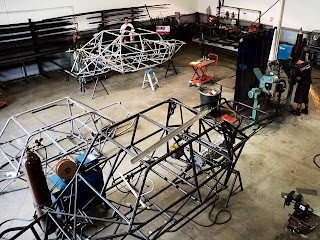ADVERTISEMENTS
Dual-sport vehicles have been around a long time, since the '60s at least. At that time, dual-sport was something like a Meyers Manx, a VW-powered, street-legal off-roader that guys like Steve McQueen drove in Baja. Lately, the boundaries of the "dual-sport" moniker are expanding rapidly. There is still a big following for the Manx and cars like it, but for those who can afford it, the trend is toward bigger, heavier dual-purpose machines. These are incredibly athletic custom cars that can comfortably tour Baja, prerun a race, or chase a team, and with the right tires, blast up the tallest dunes anywhere. Like the Manx, these cars trace their heritage and performance characteristics back to off-road racing, where the state of the art has been advancing rapidly.
We checked in with John Cooley at Alumi Craft to get an update on what kinds of capabilities today's dual-sport cars offer. At Alumi Craft, it's easy to see how off-road racing spawned a chassis industry that transferred technology to sand machines and recreational applications. Cooley builds cars anywhere from husky sand machines to prerunners and custom setups not much different from a SCORE Class 1 racer. "If it wasn't for off-road racing, there is no way this industry could be as advanced as it is today," Cooley explained. "The first sand cars we built, eight or nine years ago, were using Volkswagen engines, bus transmissions, 1,200 to 1,500 pounds - that was what we built because that was what was out in the sand. They were mid-engine, lightweight sand cars. Then we started using V-6s, because the off-road race cars were using V-6s. And then in early 2000 and 2001, the Northstar V-8s and the LS-1 V-8s came out. And from there, I think off-road racing and the dual-sport industry kind of evolved together. The cars kind of evolved into bigger, more sophisticated cars than what they were back then. Nowadays, it's nothing to build a sand car with 1,000 hp, and if it weighs 3,000 pounds, it's not uncommon."
Today's dual-purpose machines are different because of the engines. More power dictates a better-braced chassis with a longer wheelbase, more suspension travel, and much more strength. The choice of powerplants available today is truly awesome. Cooley's customers may request "Anything from a supercharged LS-1 to a big-block, like a Donovan big-block motor, something like that. You can't take a motor like that and put it a small sand car like you can with a Volkswagen motor. It doesn't work that way. You have to build a car around your drivetrain. "That's essentially why we have four different chassis. If somebody came in here and wanted to put a Volkswagen motor in a big car, we'd say, 'This isn't the car for you. We have this other car.'
The dual-sport chassis and the prerunner chassis differ in a variety of ways. "You can see where it's bigger," Cooley explains. "It's wider, longer, the tubing is bigger, it's going to be around 3,000 pounds. It's just a bigger car. It has more wheel travel. Bigger rack-and-pinion, bigger spindles, bigger A-arms, bigger shocks or dual shocks, 30-gallon fuel cell, bigger radiator - everything is bigger." A good example of what Cooley is talking about can be seen in this year's ORBA (Off Road Business Association) sweepstakes car. Cooley and his team of 10 employees designed and assembled the car, which is a dual-purpose machine built on a heavier Cooley prerunner chassis. Designed around a 134-inch wheelbase, the 4130 chromoly tube chassis will weigh about 2,800 pounds. There is 21 inches of wheel travel, front and rear, to help handle power generated by a Redline performance Chevrolet LS-1 V-8, good for 430 hp with the reliability of a stock motor. The Mendeola Racing transmission is an S-4 four-speed. Fox Racing bypass coilover shocks, with Eibach springs, guarantee control and enable precise rebound and compression tuning. Pro Comp X Terrain 35x12.50s are mounted on light Walker Evans Racing 7x17-inch bead-lock wheels. Steering is handled via a Howe 2.5 power rack with Sweet control valve, designed to minimize steering effort and control bumpsteer, even with taller tires. To keep it all cool is a Ron Davis radiator with dual fans and heat exchanger for oil cooling
Post Title → Alumi Craft Dual Sport Car Front Driver Side View
ADVERTISEMENTS







